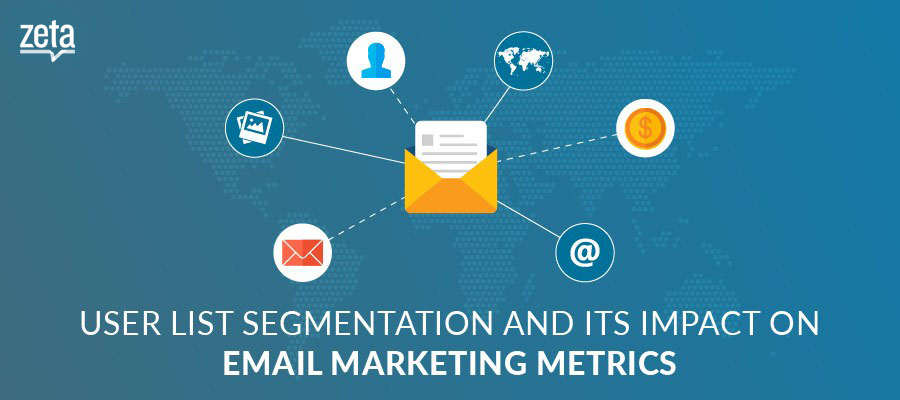
User List Segmentation and its Impact on Email Marketing Metrics
Imagine that you go to a continental restaurant that serves a variety of food. The restaurant is quite popular and is frequented by hundreds of people every evening. You decide to give it a try. You go to the place and pick the best table to gorge on some delicious food. How would you feel if the restaurant already knows your preferences in wine and your fondness for pasta salads? Wouldn’t it be nice if you get a customized menu that lists down the drinks and the food items that you love? That’s the power of segmentation and personalization. They let you serve your customers with stuff that they like.
Personalization like in the example above can be impractical and costly. However, if you run a business that has digital touchpoints with the customers, you can definitely harness the power of user list segmentation to send effective personalized communications to them across various channels like email, mobile, website messenger etc. In this post, we’re going to talk about the power of user list segmentation and its impact on important email marketing metrics like open rates, CTRs, engagement and more.
Why list segmentation?
From a small mobile gaming company to a large eCommerce brand, all kinds of businesses have to cater to a variety of customers. Even if a business sells only one kind of product or service, it will still have customers who are different from one another. So, the customer list has to be segregated if it wants to send communications (email in this case) that are relevant and personalized for individual users. And the practice of dividing the customer list into groups of people who are similar in specific ways, such as location, gender, age, interests, etc, is called list segmentation.
Here’s a simple example for customer list segmentation:
An eCommerce company creates a list of people from a particular city (say, London) to send out offers that are available only for them.
Now to the next important question: Why list segmentation?
We’re living in the age of customers and businesses today have to fight for their slice of mindshare of their customers and prospects. And the best way to do that is by personalizing the experience that the customer has with the brand. Sample these interesting statistics:

You should also read: The State of AI Powered Email Marketing in 2017 (a comprehensive report based on data of over 230 million emails!)
How segmentation helps improve email marketing metrics
Strategic segmentation results in a substantial improvement in important email marketing metrics like open rates, CTRs (Click-Through Rates), conversions, etc. We all hate generic unimaginative emails don’t we? They are mostly useless and do nothing more than annoy you with notifications after landing in your inbox. Inbox that is already cluttered with lazy generic emails by other businesses which are trying to sell you one thing or another. But, when businesses maintain clearly defined segments of their customers and prospects, they can easily send targeted emails with content that is ideal for individuals in those segments.
Increased Open Rates
No matter how strong your relationship is with the customer/prospect, you’re fighting for their attention with hundreds of other brands who send them mails every day. Even if you draft an incredibly creative and enticing email copy, you just have 3-4 seconds to capture their attention. Yes, that’s all it takes for a regular person to decide whether he/she should open the email! To convince them to open an email in such a short duration, your email should have a very catchy and relevant subject line. And segmentation gives you the ability to tailor the subject lines of the emails for individual segments of customers.
A MUST READ: Popular lifestyle content platform SHE FINDS increased its open rate by 20% using list segmentation
Better click-through rates
You can spend a lot of time and effort in A/B testing by tweaking your email subject lines, CTAs inside the email, design templates, etc. But all of it is of no use if the email content is not useful and relevant. With proper segmentation, you can send customized content to different segments/lists. Content that the customers actually want to see, click on and engage with.
Must read: How event listing platform UpOut increased its email CTR by 300%
Better engagement
You’ve just bought a nice pair of jeans from a popular eCommerce website. You get a confirmation email. But the confirmation email has special discounts for shoes that will go really well with the jeans that you’ve just bought. Won’t you feel interested in the deal? That’s the power of behavioral segmentation. Here’s how it works in the backend:
The eCommerce site has created a dynamic segment of all customers who are buying that particular brand of jeans. It has set up a triggered email campaign that gets activated for every customer who buys the pair of jeans. The triggered email has the discount coupon for the shoes. Some recipients might click on the CTA and check out the offer. Some might share it with their friends on social media and some might just forward it. Whatever the case, their propensity to engage with the content of the email will definitely increase when you customize the content of your emails like this.
Check out this case study to see how segmentation impacts engagement:
How popular Food content platform Chowhound increased email engagement by 250%
Some Final Words
When you segment your customer email database and send only relevant content to them, you will also start seeing a reduction in number of unsubscribes. You might even see an increase in deliverability since your emails will start hitting the inbox more often than being stopped by spam filters. With the right strategy and the right tools, you can leverage list segmentation and personalization to take your email marketing efforts to the next level.
If you want to know how your business in particular can benefit from Segmentation and Personalization, talk to our experts.


